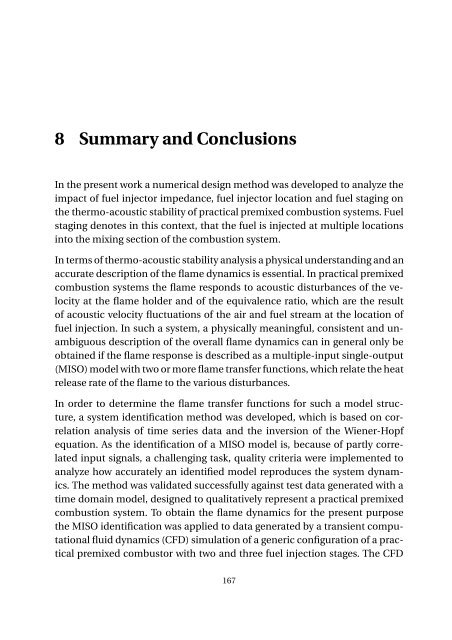Impact of fuel supply impedance and fuel staging on gas turbine ...
Impact of fuel supply impedance and fuel staging on gas turbine ...
Impact of fuel supply impedance and fuel staging on gas turbine ...
Create successful ePaper yourself
Turn your PDF publications into a flip-book with our unique Google optimized e-Paper software.
8 Summary <str<strong>on</strong>g>and</str<strong>on</strong>g> C<strong>on</strong>clusi<strong>on</strong>s<br />
In the present work a numerical design method was developed to analyze the<br />
impact <str<strong>on</strong>g>of</str<strong>on</strong>g> <str<strong>on</strong>g>fuel</str<strong>on</strong>g> injector <str<strong>on</strong>g>impedance</str<strong>on</strong>g>, <str<strong>on</strong>g>fuel</str<strong>on</strong>g> injector locati<strong>on</strong> <str<strong>on</strong>g>and</str<strong>on</strong>g> <str<strong>on</strong>g>fuel</str<strong>on</strong>g> <str<strong>on</strong>g>staging</str<strong>on</strong>g> <strong>on</strong><br />
the thermo-acoustic stability <str<strong>on</strong>g>of</str<strong>on</strong>g> practical premixed combusti<strong>on</strong> systems. Fuel<br />
<str<strong>on</strong>g>staging</str<strong>on</strong>g> denotes in this c<strong>on</strong>text, that the <str<strong>on</strong>g>fuel</str<strong>on</strong>g> is injected at multiple locati<strong>on</strong>s<br />
into the mixing secti<strong>on</strong> <str<strong>on</strong>g>of</str<strong>on</strong>g> the combusti<strong>on</strong> system.<br />
In terms <str<strong>on</strong>g>of</str<strong>on</strong>g> thermo-acoustic stability analysis a physical underst<str<strong>on</strong>g>and</str<strong>on</strong>g>ing <str<strong>on</strong>g>and</str<strong>on</strong>g> an<br />
accurate descripti<strong>on</strong> <str<strong>on</strong>g>of</str<strong>on</strong>g> the flame dynamics is essential. In practical premixed<br />
combusti<strong>on</strong> systems the flame resp<strong>on</strong>ds to acoustic disturbances <str<strong>on</strong>g>of</str<strong>on</strong>g> the velocity<br />
at the flame holder <str<strong>on</strong>g>and</str<strong>on</strong>g> <str<strong>on</strong>g>of</str<strong>on</strong>g> the equivalence ratio, which are the result<br />
<str<strong>on</strong>g>of</str<strong>on</strong>g> acoustic velocity fluctuati<strong>on</strong>s <str<strong>on</strong>g>of</str<strong>on</strong>g> the air <str<strong>on</strong>g>and</str<strong>on</strong>g> <str<strong>on</strong>g>fuel</str<strong>on</strong>g> stream at the locati<strong>on</strong> <str<strong>on</strong>g>of</str<strong>on</strong>g><br />
<str<strong>on</strong>g>fuel</str<strong>on</strong>g> injecti<strong>on</strong>. In such a system, a physically meaningful, c<strong>on</strong>sistent <str<strong>on</strong>g>and</str<strong>on</strong>g> unambiguous<br />
descripti<strong>on</strong> <str<strong>on</strong>g>of</str<strong>on</strong>g> the overall flame dynamics can in general <strong>on</strong>ly be<br />
obtained if the flame resp<strong>on</strong>se is described as a multiple-input single-output<br />
(MISO) model with two or more flame transfer functi<strong>on</strong>s, which relate the heat<br />
release rate <str<strong>on</strong>g>of</str<strong>on</strong>g> the flame to the various disturbances.<br />
In order to determine the flame transfer functi<strong>on</strong>s for such a model structure,<br />
a system identificati<strong>on</strong> method was developed, which is based <strong>on</strong> correlati<strong>on</strong><br />
analysis <str<strong>on</strong>g>of</str<strong>on</strong>g> time series data <str<strong>on</strong>g>and</str<strong>on</strong>g> the inversi<strong>on</strong> <str<strong>on</strong>g>of</str<strong>on</strong>g> the Wiener-Hopf<br />
equati<strong>on</strong>. As the identificati<strong>on</strong> <str<strong>on</strong>g>of</str<strong>on</strong>g> a MISO model is, because <str<strong>on</strong>g>of</str<strong>on</strong>g> partly correlated<br />
input signals, a challenging task, quality criteria were implemented to<br />
analyze how accurately an identified model reproduces the system dynamics.<br />
The method was validated successfully against test data generated with a<br />
time domain model, designed to qualitatively represent a practical premixed<br />
combusti<strong>on</strong> system. To obtain the flame dynamics for the present purpose<br />
the MISO identificati<strong>on</strong> was applied to data generated by a transient computati<strong>on</strong>al<br />
fluid dynamics (CFD) simulati<strong>on</strong> <str<strong>on</strong>g>of</str<strong>on</strong>g> a generic c<strong>on</strong>figurati<strong>on</strong> <str<strong>on</strong>g>of</str<strong>on</strong>g> a practical<br />
premixed combustor with two <str<strong>on</strong>g>and</str<strong>on</strong>g> three <str<strong>on</strong>g>fuel</str<strong>on</strong>g> injecti<strong>on</strong> stages. The CFD<br />
167
















